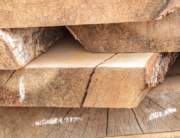Just because it’s only fall doesn’t mean that we don’t have to start thinking about winterizing our homes! Here are some great tips to get you started!
Autumn is one of my favorite times of year, rivaled only by early summer. I’m not alone – many people feel happy and invigorated during the fall season.
Yet as much as I would love to spend every afternoon basking in the last of the year’s sunny warmth, I can’t. I have plenty to do to get the house ready for the cold winter season. No matter where you live, winter probably brings a fairly significant change in climate, and homeowners have a long list of tasks to complete to winterize their homes.
I can hear your protests from here. After all, why should you have to clean out your gutters right now? I feel the same way, but let me ask you this: Would you rather clean out your gutters when it’s still pleasant outside, or when it’s freezing and your fingers are numb from scooping out wet, gunky leaf matter?
Taking care of these crucial tasks can help you save money on utility bills in the long run. Prepare for winter now, and you’ll be glad you did when cold weather settles in.
9 Tips to Prepare Your House for Winter
1. Drain Your Rain Barrels
Last year, I forgot to drain both my rain barrels before the first frost hit. In fact, I’m ashamed to say that I left the water in there all winter long. I’m amazed that the rain barrels didn’t split open from all of the freezing and thawing.
I won’t make this same mistake this year, however. Draining the rain barrels varies in difficulty, depending on the type of barrels you have. For some homeowners, draining them just means opening the spigots. Other rain barrels, like ones that I made for xeriscaping, have to be dumped out by the bucketful.
Do this in the autumn before the weather starts getting cold enough to freeze. You can save money on your water bill when you put that extra water to good use by watering houseplants, any remaining plants in your home garden, and your grass.
2. Clean Rain Gutters
Having clean gutters not only makes your home look nicer, but it can also help prevent the build-up of ice on your roof. The faster that water can drain away, the less likely it is to melt and then refreeze on your roof or under your shingles.
In addition, clean gutters reduce the risk of infestation and decrease the risk of mold in your home. If you don’t have leaf guards on your gutters, you might have to take several passes until all the leaves have fallen off the trees. While you clean your gutters, look for problem areas that may indicate that it’s time to trim the trees in your yard.
3. Trim Trees
Take a stroll around your yard and examine your trees closely. Do you see any limbs that could possibly knock out power to your home? Do you see limbs that could hit your car if they broke off during a winter snow storm?
Take time now to trim any weak branches that look as if they could cause problems during winter storms. Trimming the trees during mild weather is much easier than trying to do it when it’s frigid outside.
4. Check Your Snow Blower and Stock Up
If you live in a particularly snowy climate, it is likely that you have a snow blower. Fill it up with gas, and start it up to make sure it works. Also make sure that your shovel is still in good condition; if not, pick up another one, along with salt or sand for your driveway. People often wait until the first big snowfall to buy these crucial supplies, and stores often run out, especially if a big storm is on the way.
5. Check for Leaks
Now that the nights have cooled down, you can probably locate drafts coming into your home. Find those leaks and seal them up before winter. Walk around your home on a chilly night and, using bare hands and feet, feel around your doors, windows, lights, and switch plates for cold air.
If you detect cold air leaking in, this means that your warm air is going outside. You need to either add insulation to these areas, or seal them using weather-stripping, caulk, or spray foam. I know this can seem like an annoying chore – after all, these tiny leaks can’t make that much of a difference, right?
Well, it all adds up. Energy Star estimates that sealing the leaks around your home can help you shave as much as 20% off your heating and cooling costs, thus making your home more energy efficient.
6. Check Your Furnace Filter
Before you start running your furnace, check the filter – it may need to be replaced. If your furnace filter looks dirty, then definitely replace it. During the winter months, I change my furnace filter every 4 to 6 weeks.
Having a clean filter helps your furnace run more efficiently, which can save you energy and money. According to Planet Green, a clean filter can save you 5% to 15% on your heating bill.
Additionally, if you haven’t done so already, consider upgrading your thermostat to a programmable thermostat. Installation is easy, and the ability to program your thermostat to only work when you need it can save more money on heating during the long winter months. This is just one of many green energy technologies that you can utilize for home improvement.
7. Insulate Pipes and Hot Water Heater
Have you insulated your water pipes and hot water heater? If you haven’t, this relatively easy project can help trim your water heating costs this winter, especially if your water pipes run through a chilly or unheated basement.
According to the Department of Energy (DOE), insulating your hot water pipes can help raise the temperature 2 to 4 degrees. This can allow you to get piping hot water on a lower setting, saving you both energy and money. The DOE also states that insulating your hot water heater trims 4% to 9% off your water heating costs.
8. Add Insulation
The DOE states that adding insulation is one of the best ways to save energy all year round. During the winter months, that extra insulation makes your home feel warmer. The best news? Adding insulation to your attic is quite simple.
I’m not great at home improvement, yet I completed a winter home improvement project two years ago that went off without a hitch. Adding insulation really paid off – my heat kicked on less frequently, which helped me save energy all winter long. Best of all, this home improvement project increases value.
How do you know if you have enough insulation, or if you need more? Use the DOE’s Insulation Fact Sheet; it tells you how much insulation you need (the R-value) based on your zip code. Most homes require 12 to 15 inches of insulation in their attic.
9. Get Your Chimney Cleaned
You probably haven’t used your fireplace since last winter. Before you use it on the first chilly night, you need to have your chimney cleaned by a professional.
In addition to increasing the heating efficiency of your fireplace, an annual cleaning also helps to ensure your family’s safety during the winter months. Chimney fires, a build-up of deposits, and animals nesting in your chimney make it unsafe to use. Having the chimney cleaned every year helps to eliminate these risks for fire in your home.
Chimney cleaners are busy during the fall and winter months, so call early before the temperature really starts to drop. That way you won’t have to wait to start your first cozy fire of the season.
Final Word
The thought of doing fall home improvement can make you groan. The fall season is exceptionally busy for many people, and it’s tempting to spend your free time enjoying the last few warm, sunny afternoons out in the backyard.
However, you can easily do most of these projects, and they’re more than worth the effort. In fact, not doing these projects in fall means you’ll likely have to bundle up and take care of them after the snow starts flying, when the cold and wind can make the tasks that much more difficult and unpleasant to do.
This article was originally featured on Money Crashers written by Heather Levin.






